OChain
MSRP: €299.99 ($293.83 at the time of publishing)
Blister’s Measured Weight:
- OChain: 133 g
- Net weight gain: 119 g
Test Bike: Nicolai G1
Reviewer: 6’, 170 lbs / 183 cm, 77.1 kg
Test Location: Washington, Oregon, British Columbia
Test Duration: 6 months
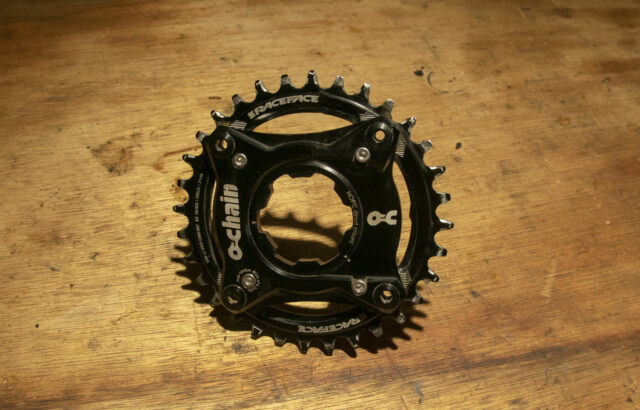
Intro
OChains started popping up in the World Cup Downhill pits a few years ago, and have since become an exceedingly common sight there. In short, the OChain device is a floating crank spider, designed to mitigate the effects of pedal kickback and improve suspension performance — but how do they work, do they work, and do you need to be a World Cup Downhiller to appreciate one? I’ve now spent six months with an OChain and am ready to weigh in, so let’s get to it:
Background Info & Pedal Kickback 101
Before we get into the OChain itself, we should step back and talk about what pedal kickback is, and why the OChain was invented to mitigate it. If you’re not interested in the theory and just want to read what the OChain does, you can skip this section, though knowing the background info will help to understand what the OChain does (and doesn’t) do.
So what is pedal kickback? In short, most bikes experience some non-zero amount of chain growth as the suspension cycles, which is to say that the distance from the top of the cassette where the chain leaves it to the top of the chainring where it picks up the chain gets longer as the suspension compresses. (The lower run of chain also tends to get longer, but we don’t care as much since the derailleur handles that part by moving the cage back and forth to take up the slack. For the purposes of this article, when I refer to “chain growth,” I’m talking about the upper portion of the chain.)
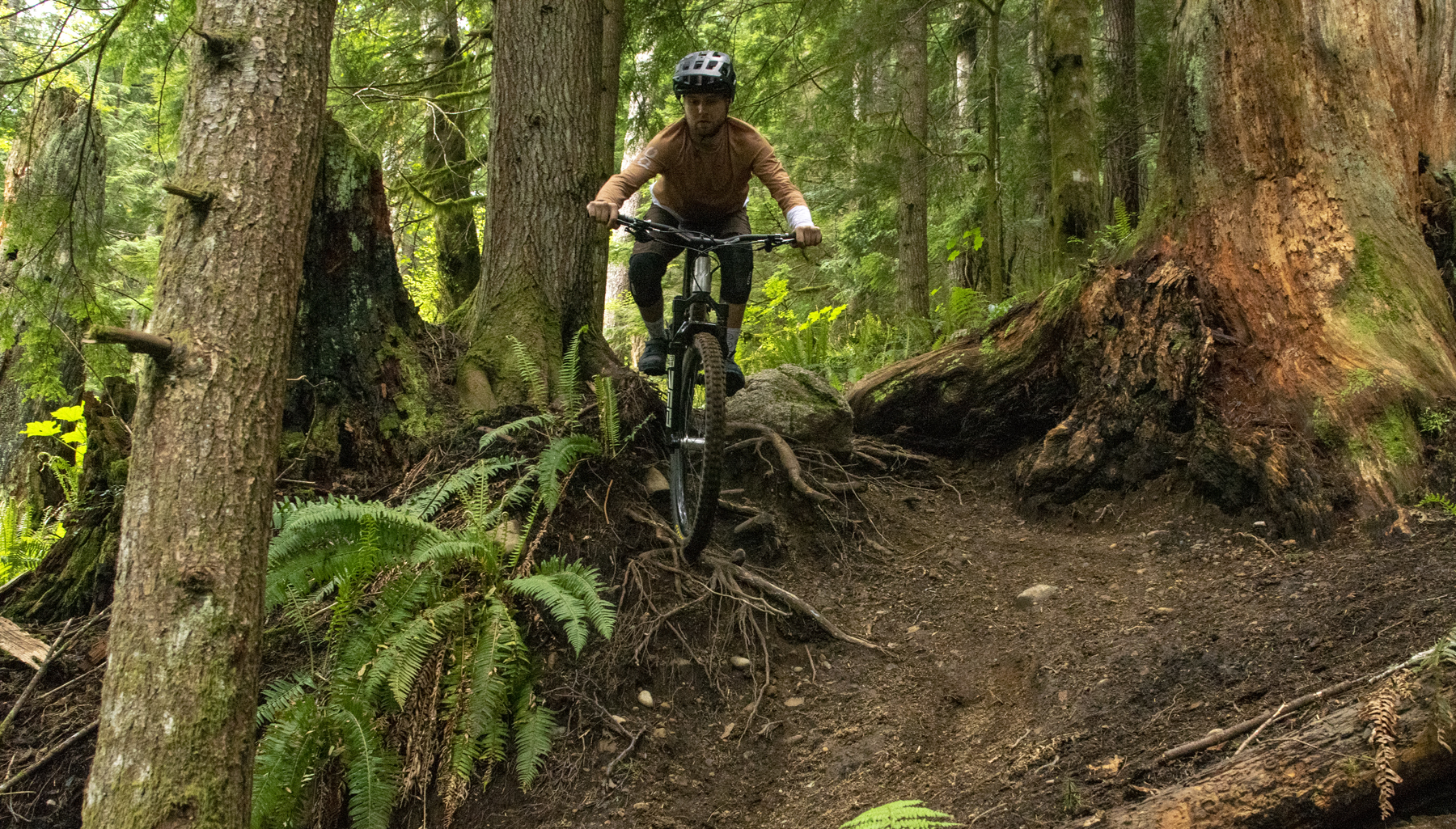
The exact amount of chain growth varies depending on both the bike in question and what gear you’re in, and pedal kickback is the standard metric used to quantify the amount of chain growth. Pedal kickback is expressed in degrees, referring to how far the crank would need to rotate backward in order to feed out enough chain to negate that chain growth; typically it is expressed as a single number (e.g. 12°), which refers to essentially the worst-case scenario for a given bike and the slate of gear combinations that it is spec’d with. On most modern bikes with conventional drivetrain layouts (i.e., not high pivots with an idler), there tends to be more pedal kickback in lower gears, and less in higher ones. In a given gear, pedal kickback starts at zero at suspension top-out (before anything has moved) and generally increases in a nearly straight line, reaching its maximum value when the suspension is bottomed out. Again, this is for conventional drivetrains — high pivots with an idler pulley get more complex, but also tend to have very little pedal kickback in general. To give some general ranges, 30° of pedal kickback is a lot, but not unheard of; something in the 12° to 20° range is fairly normal; anything under 5° or so is very little.
So why do we care? Because pedal kickback can hamper rear suspension performance. If you’re experiencing pedal kickback, the chain forces are tugging at the crank, rotating your feet back to allow the suspension to keep moving. And since a lot of your weight is going through your feet to the pedals, your body weight is going to tend to resist that movement. Or, to look at it differently, if the chain is pulling on the crank, it’s also pulling on the rear wheel, and through it the rear suspension, due to Newton’s Third Law of equal and opposite reactions. Pedal kickback is therefore resisting suspension movement, and hindering the rear suspension from moving as freely as it would otherwise.
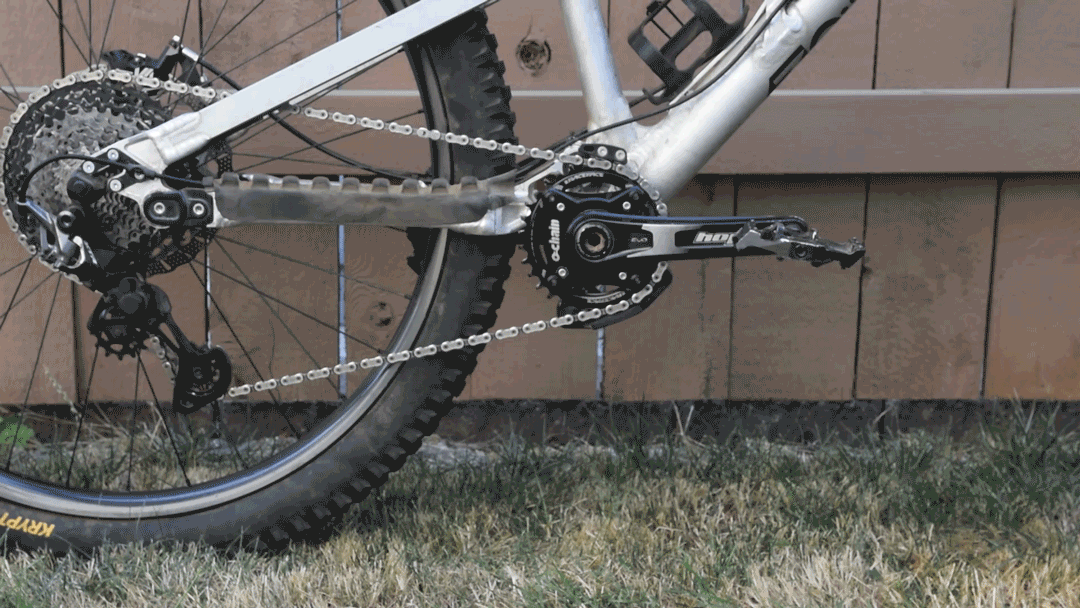
That tends to feel like a loss of small bump sensitivity and an increase in initial harshness as the suspension starts to move. If you’re hitting something hard enough to get deeper into the travel, that force is going to be great enough to pull your feet backward slightly and let the suspension keep moving once it does so, but the slight hesitation you get from it hampers the suspension’s ability to move freely from the instant that you hit the bump, and some harshness and extra feedback is the result.
There’s a catch, though. In order to actually experience pedal kickback, you need to first turn the cassette forward enough for the freehub mechanism in your rear hub to engage, and lock the rotation of the cassette and wheel together. To make the math easy, let’s say you have a hub with 36 points of engagement, for 10° of rotation between each point. If you have to rotate the cassette forward by 10° before the freehub engages, you effectively get however much chain length that feeds out for “free” before any pedal kickback actually happens. If you’re in a 1:1 gear ratio (i.e., same size cassette sprocket as chainring), that cancels out 10° of pedal kickback. If you’re in a 2:1 gear (e.g., 32 tooth chainring and a 16-tooth cassette sprocket) the cassette has to rotate twice as far to feed out a length of chain equal to a given amount of rotation at the chainring, so you only get 5° of cancellation.
But of course, that 10° of freehub movement is the best-case scenario, as far as pedal kickback is concerned, for your 36 POE rear hub. Maybe when you hit a bump the freehub will have *just* moved past one click, and there will be 10° of rotation until the next one; maybe it will have just engaged, and there will be none at all. Most of the time it’ll be somewhere in between. So the average amount of freehub movement before it engages will actually be 5°, and the amount that you get on any given impact will be somewhere between 0° and 10° at random. So the more points of engagement that your rear hub has, the less pedal kickback the freehub will absorb on average, but even a very slow engaging hub can’t be counted on to reliably mitigate pedal kickback.
And then there’s a catch to the catch. In order for the freehub to engage, it has to be spun forward faster than the rear wheel itself is spinning. On a sharp impact, your rear suspension can compress very quickly, but it’s still not instantaneous. If your bike and current gear combination theoretically produces 15° of pedal kickback, even if your freehub just so happens to be engaged at the exact moment you hit a bump, if the rear wheel is rotating fast enough that it turns 15° (assuming you’re in a 1:1 gear; a different gear ratio makes the numbers more complex but doesn’t change the fundamental idea) in the time that it takes the suspension to compress to bottom-out, you still won’t actually get any pedal kickback.
So that’s the rundown. Pedal kickback is detrimental to suspension performance, but the exact parameters of when and how it occurs are complex, depending on the bike in question, the gear you’re in, your rear hub engagement, and how fast the rear wheel is spinning as your suspension compresses. In summary:
- The nominal amount of pedal kickback is a property of the bike frame in question (a part of its suspension kinematics) and the gearing combination that’s selected.
- Generally speaking, most bikes have more pedal kickback in lower gears and less in higher ones.
- Lower engagement hubs reduce the likelihood and degree of pedal kickback, on average, but their effect is essentially randomized and variable.
- The faster the rear wheel is turning, the less pedal kickback you’ll experience.
Got all that? That (finally) brings us to the OChain:
Design and Options
In short, the OChain is a replacement spider that mounts to most modern mountain bike cranksets in place of a direct-mount chainring and can rotate backward to absorb pedal kickback without pulling on the pedals. A standard 104 mm BCD chainring (remember those?) bolts to the outer moving part of the OChain, so chainring options are plentiful, and the OChain is available for most common direct-mount crank configurations, including SRAM, Shimano, RaceFace, Hope, and e*thirteen; check out their website for all the details.
In principle, the OChain does the same sort of thing as the freehub does when it comes to mitigating pedal kickback — which is to say, adding some free movement before the chain goes fully taut and starts to pull on the cranks — but with one crucial difference: the OChain operates on a set of elastomers that spring it back to the extended position when it is unloaded, so it’s always in position to mitigate pedal kickback, in contrast to the randomized effect of the freehub. [Check out the theory section, above, if you’re unclear on that.]
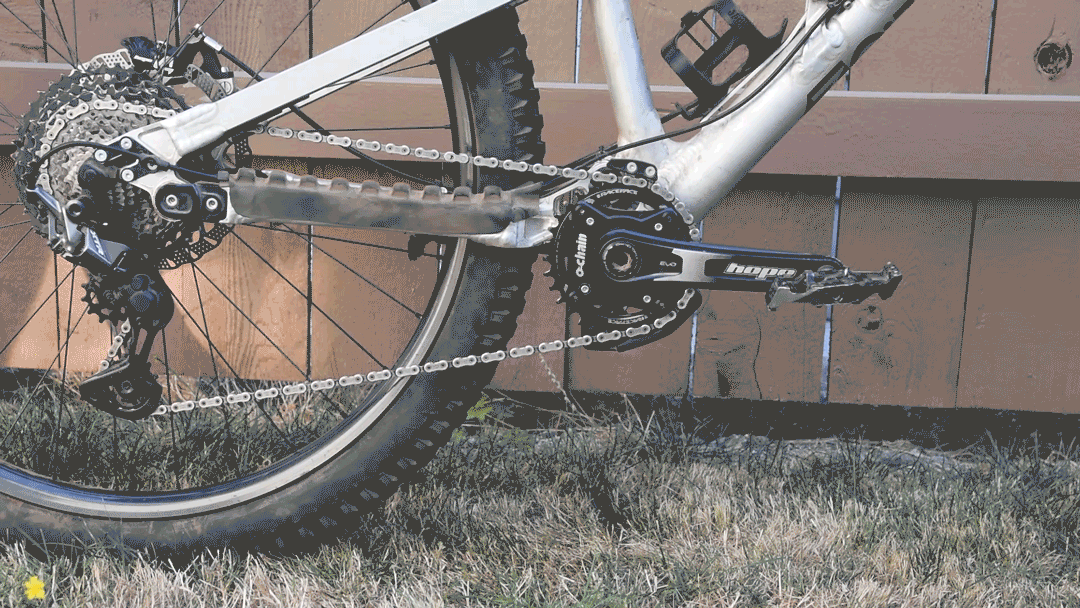
And that’s essentially it. The OChain comes with a few different sets of elastomers and travel stops so that it can be configured with 4°, 6°, and 9°; a 12° option is also available, sold separately. The 6° comes pre-installed, but swapping between configurations is quick and easy (more on that below). OChain recommends using the 12° option only on DH bikes, saying that the elastomers don’t last long under significant amounts of pedaling, but the shorter-travel options have their blessing on Trail and Enduro bikes as well.
Installation & Setup
Installing the OChain is functionally the same as any other direct-mount chainring, with the added step of bolting a standard four-bolt chainring onto the OChain unit. If you’ve got the right tools, it’s dead simple and only takes a few minutes.
The OChain is, unsurprisingly, a bit thicker than a standard direct-mount chainring and does eat slightly into the clearance between the inside face of the chainring and the frame or chainguide (if applicable). In my case, with a Hope Evo crankset and Cascade Components chainguide on my Nicolai G1, this was a non-issue, but depending on your setup, you might need to mess around with bottom bracket and/or crank spindle spacers to buy a little more clearance.
I did find myself wanting to use some spacers on the chainring bolts to move the chainline inboard by about 4 mm, but those were readily available at my local bike shop, along with the requisite longer chainring bolts to accommodate them. OChain now sells their own chainline spacer kit, complete with longer bolts, but it wasn’t yet widely available when I started testing. There’s nothing OChain-specific about their bolts or spacers (though the bolts are Titanium) and regular four-bolt chainring hardware works just fine.
Changing the travel configuration is also quite straightforward. You will need to remove the OChain from the crank arm, which in turn requires taking the crank off the bike. With that done, you simply install OChain’s service tool (really just two wooden discs with a bolt and wing nut going through them, which sandwiches the OChain and holds everything together while you disassemble it) and undo the bolts holding the two halves of the OChain together. With those removed, the halves come apart, exposing the elastomers and travel stops. Simply pick those out, drop in the desired ones, and bolt everything back together.
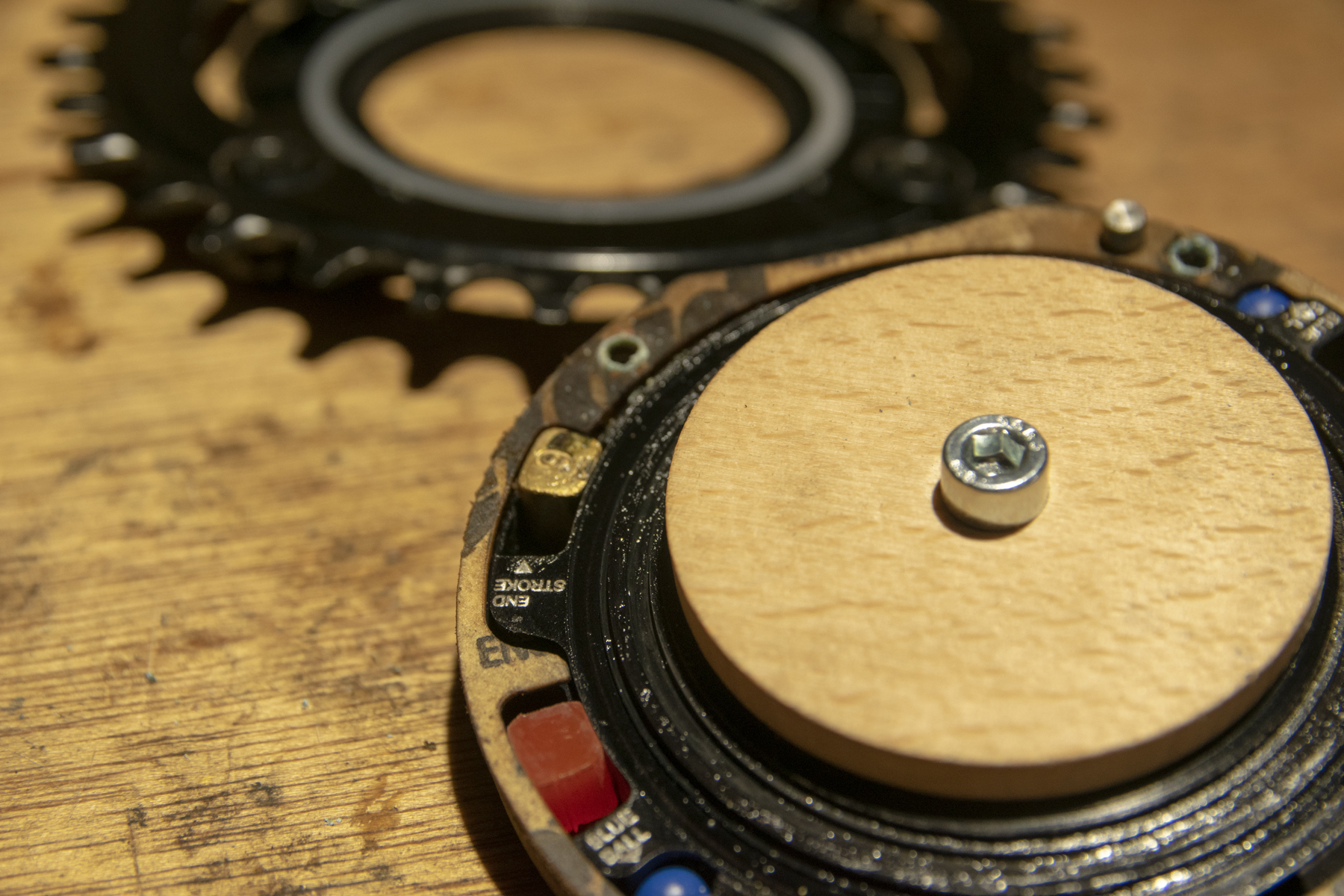
On the Trail
My Nicolai G1 strikes me as an excellent test bed for the OChain — it’s a long-travel, descending-focused Enduro bike that gets pedaled to the top of most of its descents, and has quite a bit of pedal kickback (around 30° in the lowest gears, but more like 10–14° in the higher ones, where you’d realistically be just about any time you’re using full travel). So I bolted up the OChain, initially in the standard 6° configuration, and hit the trail.
Climbing
Unsurprisingly, having an OChain installed makes your rear hub engagement feel slower. You essentially need to pedal through the free stroke in the OChain (which is consistently set to whatever elastomer configuration you’ve installed) and then once that’s caught and starts pulling on the chain, you engage the rear hub normally. The duration of my testing was done with Hadley (72 POE) and Industry Nine Hydra (690 POE) hubs, which is to say, “quick” and “absurdly fast,” respectively.
I’ve long been on the record as saying that ultra-fast engaging hubs aren’t a huge upgrade for most people, and my time on the OChain hasn’t changed my mind on that front. Especially when paired with a fairly fast engaging rear hub, the 6° OChain setting felt totally unobtrusive for most of my riding, and the 9° one was still fine. Really the only time it bothered me at all was when ratcheting the pedals through a section of a technical climb, when the added free rotation from the OChain meant that I just couldn’t put down as much power with a partial pedal stroke, since a larger portion of it was wasted — just like with a slower engaging hub.
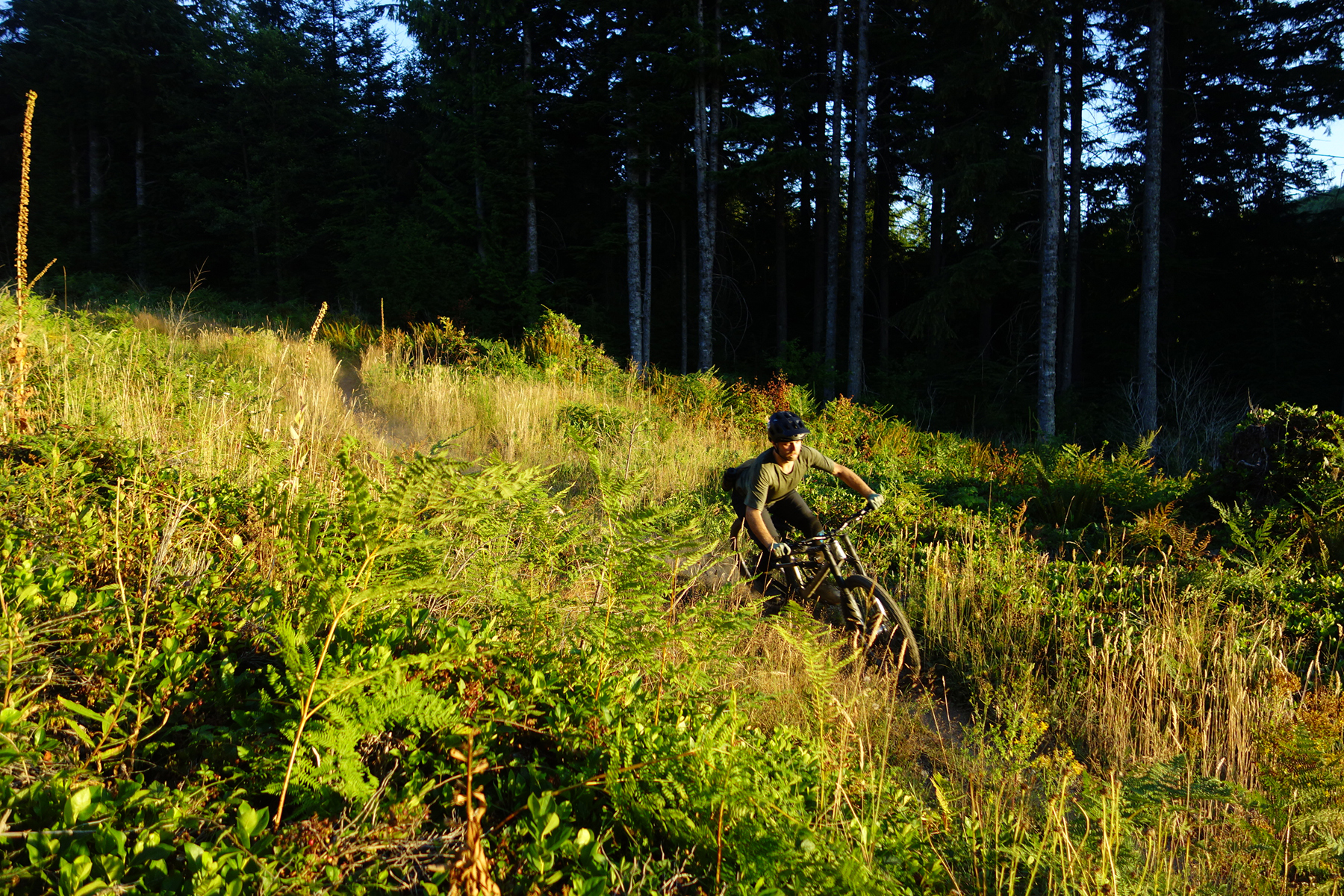
When the terrain let me pedal smoothly and consistently, the OChain felt completely normal. As long as you’re pedaling a smooth enough stroke to keep the chain taut and the OChain engaged, it feels like a normal, solid chainring. And it’s not like you need to be especially careful to maintain a smooth stroke for that to be true or anything — the OChain really felt like my rear hub was slower to engage, but nothing more.
One area where the OChain’s behavior was notably quirky, though, was when trying to clip my first foot into my pedal, when standing still with the other foot still on the ground. The OChain turns the pedal into a bit of a moving target, but unlike the play you get from a freehub in that same situation, the OChain means that the pedal springs back to its original position if you take pressure off it. And that does make it harder to clip in with your first foot when getting started. Once you’ve got one foot on a pedal and can control the crank position with that, it’s a non-issue — even if that first foot isn’t actually clipped in yet — but is harder with just one foot in play and the other on the ground. Not a big deal by any stretch, but an amusing quirk that I hadn’t considered going in.
Descending
It’s on the way back down, though, that the OChain is really supposed to help, and it does. Sometimes.
To be honest, a lot of the time, the OChain doesn’t really feel noticeably different than a normal chainring. And that makes sense — even on a bike like the Nicolai G1, which has a good bit of pedal kickback on paper, you’re not going to actually experience pedal kickback every time you hit a bump. A lot of the time the OChain isn’t doing a whole lot. But the good news is that I also didn’t find it to do anything unwanted or annoying. I just couldn’t notice it much one way or the other.
But there’s one area where the OChain did make a big difference, for the better for me, and that’s when braking through a fast, rough section of trail. The differences were a lot more subtle if I was off the brakes, but under braking, the suspension performance was significantly improved. Most significantly, the bike felt like its initial sensitivity was quite a bit better, with less chatteriness and feedback in those circumstances.
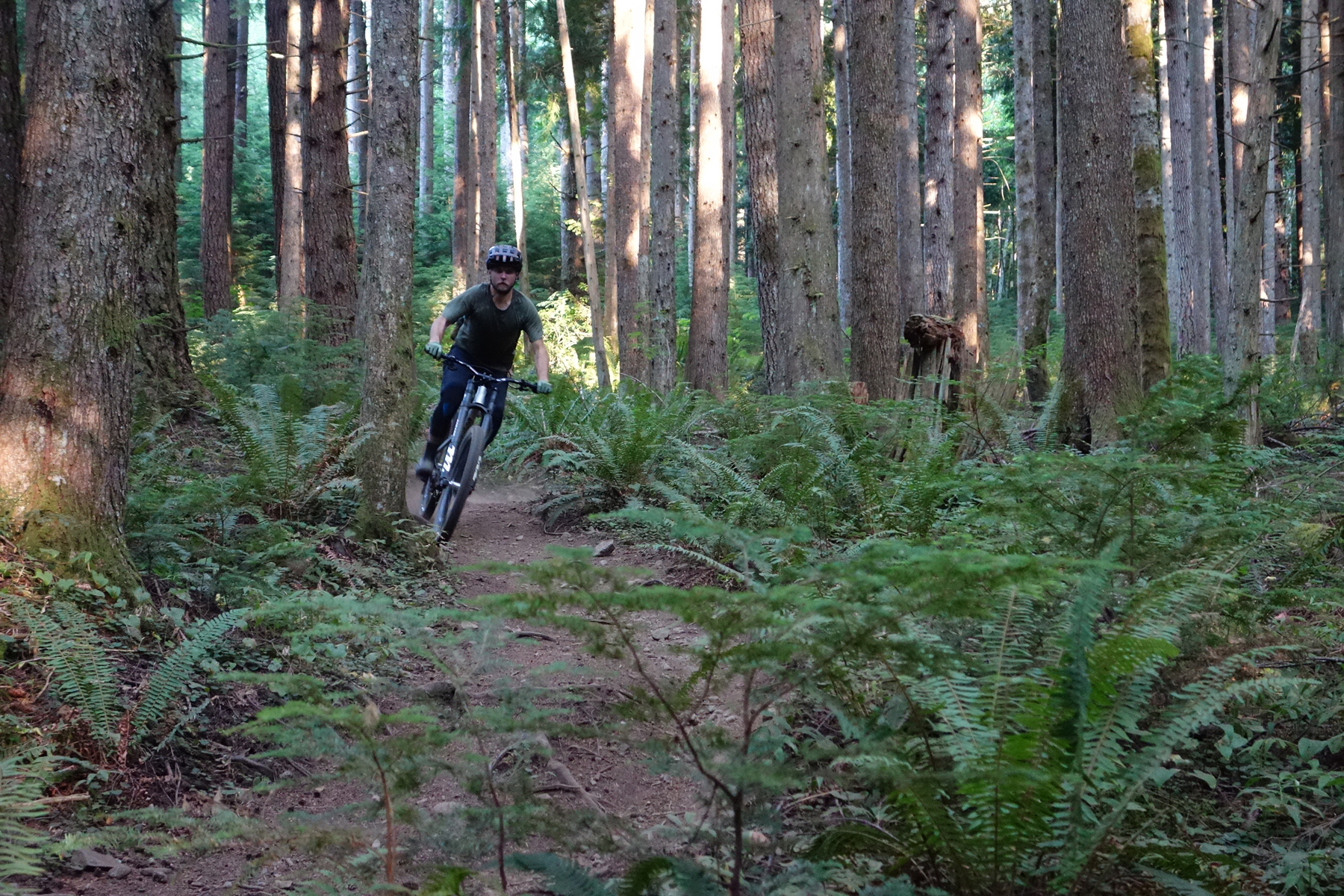
And I think that makes sense, too. If the rear wheel is rolling quickly, the rear suspension has to compress a lot faster for you to experience pedal kickback than if the rear wheel isn’t moving. If you’re riding hard through a fast, rough section, there’s a tendency for the rear wheel to skip around and lose traction as you skim over holes, then abruptly re-establish traction as it hits the back edge of the hole or the next bump. And if you’re on the brakes in that scenario, the rear wheel is going to lock up in those moments when it loses traction, and therefore not be turning at the instant that it hits the next bump. That’s a perfect recipe for pedal kickback, even if the wheel starts turning again an instant later, and comparing the OChain against a normal chainring on the same section of trail back-to-back, the difference was clear. The OChain made the bike feel smoother and more composed, with less feedback transmitted through the rear suspension.
That’s not to say that the OChain was only noticeable when I was on the brakes, but its impact was more pronounced in those instances. And while I noticed an improvement in suspension performance when using the OChain with clipless pedals, there was an additional benefit to pairing it with flats.
In short, my foot placement felt more secure on flat pedals with the OChain than without. And while I noticed a bit of an improvement in fast, rough sections, especially while braking — the same scenarios where I noticed the most gains in terms of suspension performance — the bigger difference in terms of foot placement actually came on awkward, low-speed impacts, such as a flat, low-speed landing or a mistimed hop over a hole where the bike and I got hung up on the back side.
And that kind of makes sense, too. As we’ve already outlined, having the rear wheel spinning slowly is a recipe for actually experiencing pedal kickback, and so that’s when the OChain should theoretically make a difference. Interestingly, I didn’t notice as much of an improvement in suspension performance in those sorts of low-speed situations as I did under high-speed braking (maybe because an awkward flat landing just feels terrible no matter what?) but I definitely felt my feet getting pulled around less with the OChain.
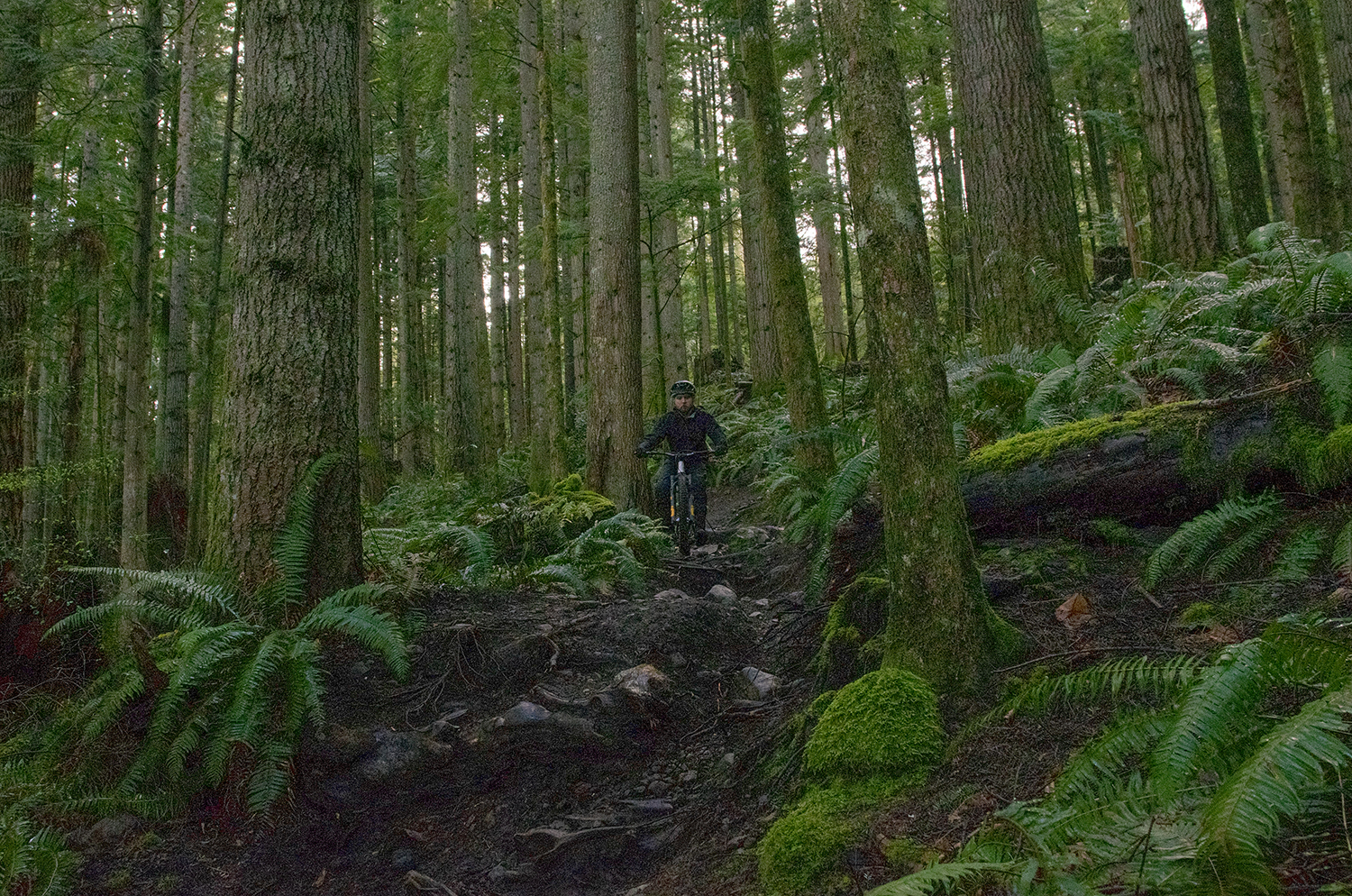
Would I call any of those improvements night and day? Probably not. But the OChain made the rear suspension on the G1 feel appreciably smoother and less harsh in certain situations, most notably under braking in fast, rough sections, and did so without introducing any major downsides. Mountain bike suspension kinematics have gotten much better refined in recent years, and I don’t think that pedal kickback is going to be a massive issue for most riders on most modern bikes, but it’s still real and the OChain does appreciably mitigate it.
Durability
One of the biggest questions I had with the OChain was how long the elastomers would last, especially on a bike that’s primarily being pedaled to the top, since the elastomers are compressed whenever you’re on the pedals and the chain is under tension. And the answer is “really well.” I spent the bulk of my six months of testing with the stock 6° elastomers in place, and while they’re showing a little bit of visible wear, it hasn’t caused any problems so far and they’re still working well. I’m sure they won’t last forever, and adding an OChain does introduce one more thing to keep tabs on and maintain, but my take at this point is that it won’t be a big deal for all but the most maintenance-averse folks out there. Replacing the elastomers when the time comes is quick and easy, and given my experience thus far of having no need to after six months of heavy use, I’ve got nothing to complain about.
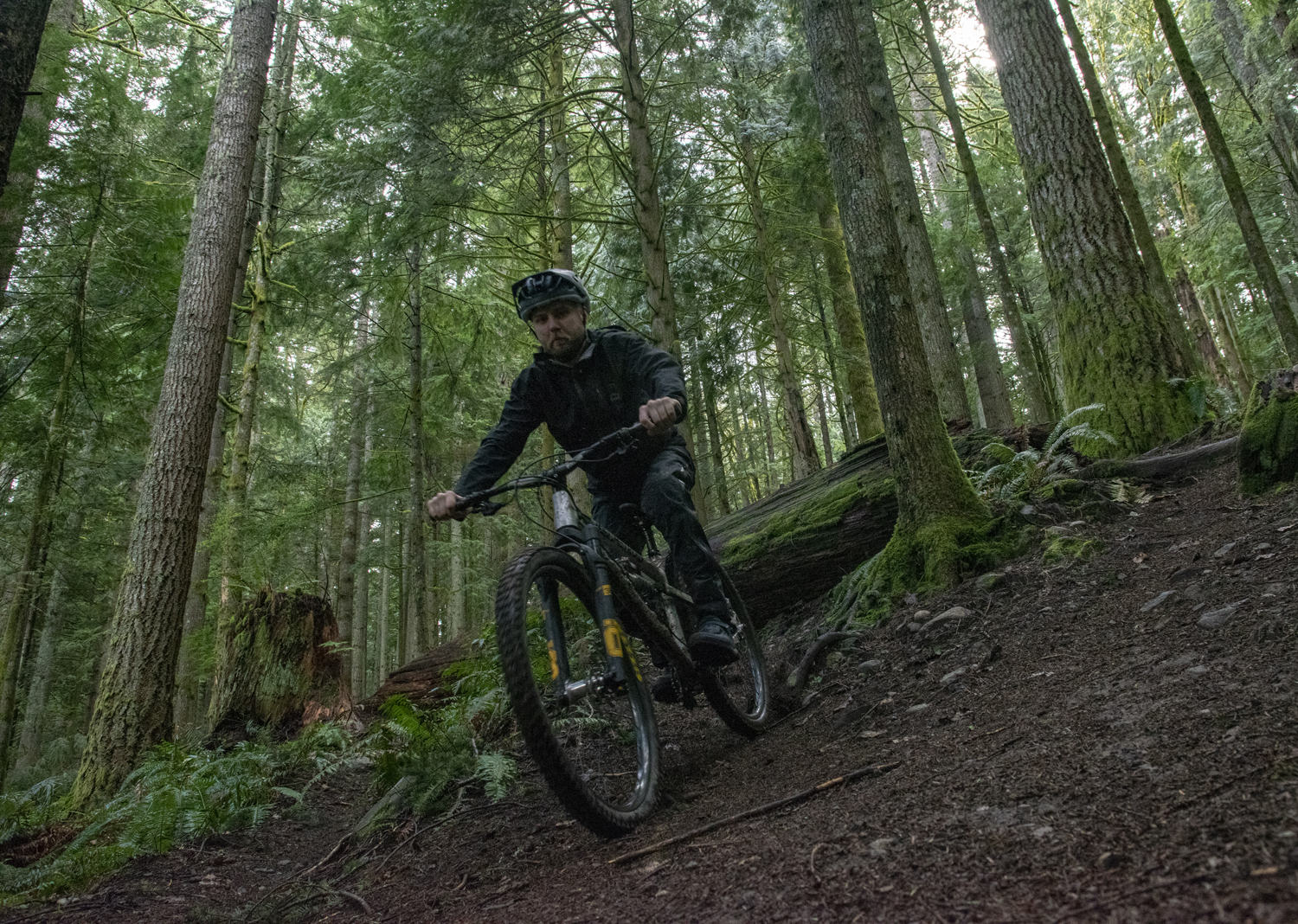
Who’s It For?
OChain’s effectiveness is going to vary depending on the bike in question, and will be of most benefit to folks on bikes with significant pedal kickback, riding in faster, rougher terrain. It doesn’t make a difference all the time and in every situation, but apart from the loss of engagement and the impact that has on technical climbing, I don’t think there are too many downsides, either.
So I’m not at all surprised that OChains are popping up all over the place in the World Cup DH ranks. Technical climbing is irrelevant in that arena, and finding any little edge available when it comes to downhill performance is critical. Between that and how modest the tradeoffs are, OChains pretty clearly make sense for those folks (with some exceptions for bikes with especially low pedal kickback).
The answer for everyday riders is a little trickier. An OChain isn’t going to make a night-and-day difference on most bikes in most situations, but if you go into it expecting marginal gains in some situations, with few tradeoffs (again, apart from technical climbing) you’ve got the right idea. If that sounds worth it to you, the OChain really does work.
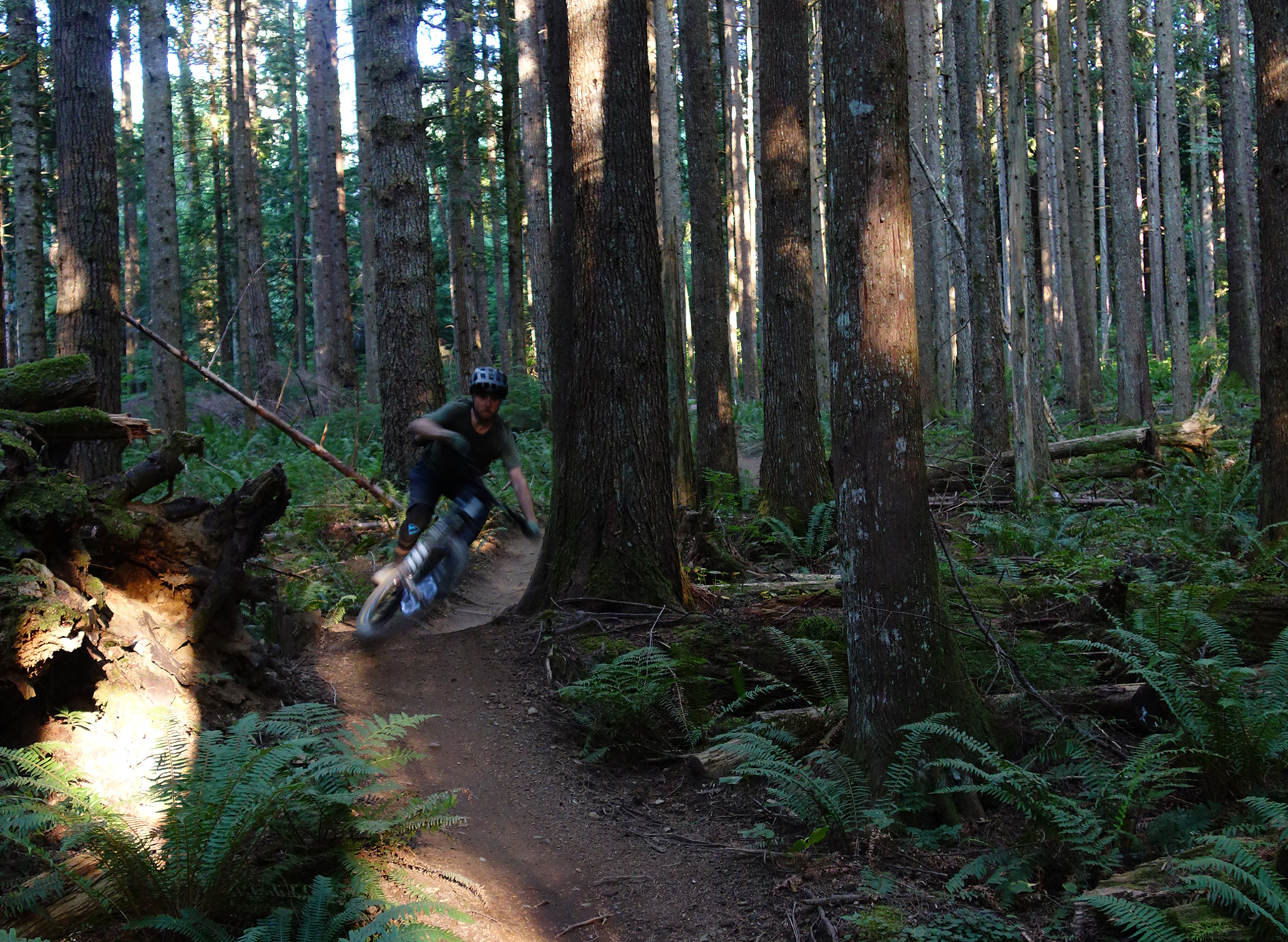
Bottom Line
Having now spent time using one for about half a year, OChains’ popularity on World Cup DH tracks makes sense. They do a nice job of mitigating pedal kickback with few downsides, and for folks making their living racing on very fast, rough tracks where any little edge they can get is valuable, an OChain makes a ton of sense.
Whether the cost is worth it for you is between you and your bank account. The OChain is going to be of most benefit to folks riding a lot of fast, rough, trails, and while it makes a difference no matter which pedals you’re using, there are some extra upsides of pairing the OChain with flat pedals. And of course, the extent to which an OChain has the potential to make a difference also depends significantly on the bike in question (particularly, a given bike’s level of pedal kickback).
All that said, I’m impressed with the OChain — particularly in that there are fewer downsides and quirks to running one than I thought there might be. It’s a well-made, well-designed product that is probably better thought of as making an incremental improvement in some circumstances than something that’ll completely transform the ride of most bikes, but for the right riders, that improvement will be worth it.

What water bottle holder have you got on the G1 in the “pedal kickback” clip above? And what size G1 is it on?
It’s a Jank Components beer holder, on a medium frame. It *just* barely fits with a custom bracket that ties into the cable routing bosses.
I just set up my new Transition Spire with a I9 hydra, first time with such a quick engaging hub but after the first ride was impressed with it on techy climbs and out of corner speed. That being said, I did notice some knocking in braking bumps or fast technically descents that I hadn’t felt before on a brand new bike. Almost felt like the shock mounts were already blown and running flats my feet definitely didn’t feel as glued to the pedals as my previous setups. The OChain setup caught my eye thinking it could help with this issue to get a balance of both worlds or maybe very high engagement hubs aren’t for me haha. Let me know your thoughts
Do I understand correctly, that high degree engagement hubs is quite effective solution against pedal kickback? I run on DT 20 degr. ratchet LN freehub.